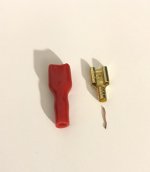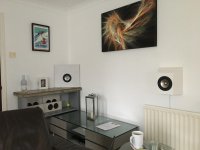Worth every penny IMHO. You will need the highest quality carbide tipped saw blades and router bit you can afford, but the results will speak for themselves.
That last ply was BauBuche, its Beech layers and super thick, comes in 40mm sheets. Its the front runner for the main plinth of the turntable I am developing.
If MDF is super easy to get, why not make a quick cabinet in MDF? You can refine the design.
If Birch ply is your thing, it might be worth seeing if you can get it pre-cut (AvonPlywood over here does an amazing job) and send it over. Ive got some parts cut for my CHN-50 cab and a two pairs of parts barely fills a shoe box...
If MDF is super easy to get, why not make a quick cabinet in MDF? You can refine the design.
If Birch ply is your thing, it might be worth seeing if you can get it pre-cut (AvonPlywood over here does an amazing job) and send it over. Ive got some parts cut for my CHN-50 cab and a two pairs of parts barely fills a shoe box...
Holy ****, that is beautiful plywood!
got to say, it is really appealing. perfect for my taste.
Worth every penny IMHO. You will need the highest quality carbide tipped saw blades and router bit you can afford, but the results will speak for themselves.
wouldn’t mind spending on this beauty at all, my only concern is i don’t trust anyone here to cut it. it’s not worth getting it cut by unskilled workers. although i’ve some basic woodworking knowledge, yet i’m still in that aforementioned category.
That last ply was BauBuche, its Beech layers and super thick, comes in 40mm sheets. Its the front runner for the main plinth of the turntable I am developing.
If MDF is super easy to get, why not make a quick cabinet in MDF? You can refine the design.
If Birch ply is your thing, it might be worth seeing if you can get it pre-cut (AvonPlywood over here does an amazing job) and send it over. Ive got some parts cut for my CHN-50 cab and a two pairs of parts barely fills a shoe box...
yeah, it would be super easy to build mdf cabinets, and have an automotive finish too. but, since it’s been frowned upon here, i thought what other options available for this build. all in all, i’m getting both mdf sheet(s) and a baubuche sheet. will do a demo with mdfs, and if i find the right person to do the job on the baubuche, then i will be conformable.
AvonPlywood over here does an amazing job)...
Would you mind my asking what sort of price do Avon charge for a cabinet to be cut?
Keep in mind that the CAT series of network cabling is designed primarily for crimp connectors such as RJ45, wherein 8 separate conductors can he housed in an approximately 1/4” plug, or punching down in terminal strips, etc.
RJ45 - Google Search
Was never intended to be soldered, and care must be taken when stripping insulation to avoid nicking the copper.
RJ45 - Google Search
Was never intended to be soldered, and care must be taken when stripping insulation to avoid nicking the copper.
@Jimk04, There sheets are not the cheapest (+/- 15% more than other timber sellers) but there. cutting is cheap...approx 50p a cut.
I often add about £8-£15 on for a sheet to cut up. It's cheaper than me doing it!
And their precision saw is 99.5% of the time absolutely bang on. Plus their computer optimises it, so you just send a spreadsheet and they choose the best sheet (10'x5' sometimes yield better)
I just cut a load of 12mm ply (part of another job so added the parts on) and there are lots of parts for the CHN-50 that are 100mm x 120mm, these are a pain to cut on our table saw.
I think you can do a quote online now, or we still use their spreadsheet and email it over. They can edge too if you wanted lipped veneered board, we have also used the oak veneered birch they sell for lots of projects, which is a great un-compromising half way house...
I often add about £8-£15 on for a sheet to cut up. It's cheaper than me doing it!
And their precision saw is 99.5% of the time absolutely bang on. Plus their computer optimises it, so you just send a spreadsheet and they choose the best sheet (10'x5' sometimes yield better)
I just cut a load of 12mm ply (part of another job so added the parts on) and there are lots of parts for the CHN-50 that are 100mm x 120mm, these are a pain to cut on our table saw.
I think you can do a quote online now, or we still use their spreadsheet and email it over. They can edge too if you wanted lipped veneered board, we have also used the oak veneered birch they sell for lots of projects, which is a great un-compromising half way house...
It was also never intended to be used as speaker wire 🙄
Matt, don’t you ever get tired injecting fact and logic into a good narrative? 😉
FWIW, CAT4/5/6 will work for speaker wire - I’ve done so myself- but have gone back over to the dark side and am currently using standard #16 AWG for long runs to my FR drivers, and #12 for HT subs.
It was also never intended to be used as speaker wire 🙄
Here you go Matt.
Neotech UPOCC 24 AWG Teflon Insulation Cryo Treated - Neotech Cryo Treated Copper & Silver Hook-up Wire -
dave
I solder directly to the terminals avoiding spades or any slip-on connectors.
dave
great, will try that.
Keep in mind that the CAT series of network cabling is designed primarily for crimp connectors such as RJ45, wherein 8 separate conductors can he housed in an approximately 1/4” plug, or punching down in terminal strips, etc.
RJ45 - Google Search
Was never intended to be soldered, and care must be taken when stripping insulation to avoid nicking the copper.
well, i’ve also ordered the amazonbasics 16awg one for keeps just in case it’s needed. so, i’m safe on that regards. cheers for the heads up.
@Jimk04, There sheets are not the cheapest (+/- 15% more than other timber sellers) but there. cutting is cheap...approx 50p a cut.
I often add about £8-£15 on for a sheet to cut up. It's cheaper than me doing it!
And their precision saw is 99.5% of the time absolutely bang on. Plus their computer optimises it, so you just send a spreadsheet and they choose the best sheet (10'x5' sometimes yield better)
I just cut a load of 12mm ply (part of another job so added the parts on) and there are lots of parts for the CHN-50 that are 100mm x 120mm, these are a pain to cut on our table saw.
I think you can do a quote online now, or we still use their spreadsheet and email it over. They can edge too if you wanted lipped veneered board, we have also used the oak veneered birch they sell for lots of projects, which is a great un-compromising half way house...
maybe, just maybe, this is an option for later on. only if i can find birch ply here, i would dream a bit. warehouses used to stock it, but it was gone before it was even on sale. don’t know why it’s not available anymore.
…16awg...
Try both, use the one that works best in your system.
dave
It was also never intended to be used as speaker wire 🙄
At the risk of injecting logic into the proceedings -who cares what it was intended for? It's just insulated copper wire and carries the signal in the same way any other insultated copper wire of the same gauge and configuration does. I can't say I use it myself, but there are no functional issues behind doing so providing some basic understanding of electrical engineering is applied to whatever end gauge and configuration happens to be used. If we were all obliged to use items specifically marketed for a specific use and no other, a large proportion of DIY constructions wouldn't exist.
Last edited:
FFS, you can use an enamelled metal coat hanger or “Romex” as speaker wire, and neither of those where designed as audiophile approved boutique grade jewelry.
Hell, maybe even a wet enough dirty shoestring could conduct electricity 😉
When it first hit the tweak-o-phile radar screen a couple of decades ago, I even experimented with some of those crazy braiding schemes of multiples of the full 4 pairs. Carefully stripping all those #24 conductors without nicking or breaking them off was a royal painindiaz - even more so when using the Teflon insulated “plenum grade” that was the gold standard of sanctioned Kool-aid.
Hell, maybe even a wet enough dirty shoestring could conduct electricity 😉
When it first hit the tweak-o-phile radar screen a couple of decades ago, I even experimented with some of those crazy braiding schemes of multiples of the full 4 pairs. Carefully stripping all those #24 conductors without nicking or breaking them off was a royal painindiaz - even more so when using the Teflon insulated “plenum grade” that was the gold standard of sanctioned Kool-aid.
That would be better, less brittleyou can use an enamelled metal coat hanger or “Romex” as speaker wire
I thought brittleness was normally used in reference to the properties of a given material rather than its proportions. Be that as it may, re vulnerability of different wire gauges, implementation plays a major role, although certainly some common sense needs to be applied to thinner gauges which may be more at risk of accidental breakage by pets & ham-fisted oafs (like muggins here) etc. when this is potentially an issue. I doubt anyone would disagree with that. Enamelled wire needs a bit more care too since the dielectric may be more susceptible to damage than other types.
Last edited:
- Home
- Loudspeakers
- Full Range
- New Markaudio Drivers

